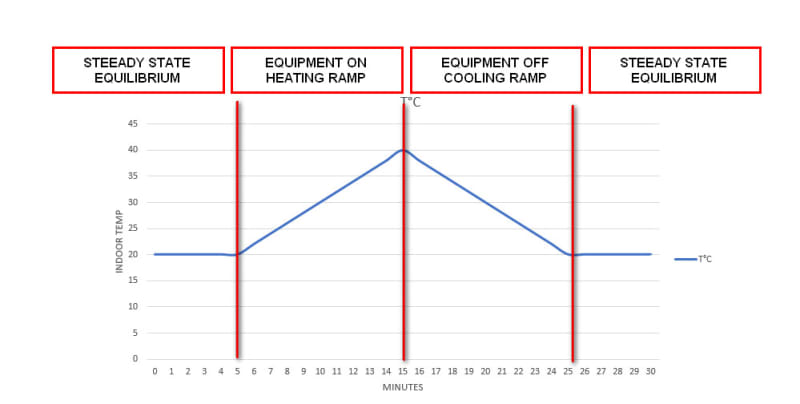vinhermes
Marine/Ocean
- Aug 29, 2009
- 36
Good morning to you all,
For a series of ships (tugs) actually being built, I am facing an HVAC engineering issue. To start with, I should say that we only do steady-state calculations using ISO 7547, SNAME T&R Bulletin 4-16 or equivalent. In other words, for technical rooms, we calculate ventilation flowrates and/or FCU’s powers so that the Delta T ensures that we remain below the maximum temperature knowing all the heat gains (+ verification of R/C required of course).
But I have a specific room (thruster room) in which is an equipment with a relatively high dissipation (15 kW) but only used over a limited period of time (10 minutes per hour maximum).
The first option, ventilation only, has been discarded as we could not integrate the ducts and goosenecks associated with such high flowrates. So we decided to go for an FCU in the room. Knowing all the heat gains, etc., when doing steady-state calculations, we reach a cooling load requirement of 17 kW. This will be very difficult to integrate and this small room with a piece of equipment used once in a while becomes the biggest consumer for the chilled water unit…
So here is my question, how would you do a dynamic calculation so that, knowing by iteration the power of the FCU :
- We know the initial temperature at equilibrium with the equipment off
- We calculate the heating ramp based on the dissipation over 10 minutes
- We calculate the cooling ramp when the equipment is stopped
- We get back to the initial equilibrium temperature with the equipment off in less than 50 minutes so that we are ready to start the equipment again
Here is a sketch to clarify if needed:

Main data are :
- Maximum temperature indoor temperature: 45°C
- Outdoor conditions : 37°C, 110 kJ/kg, 70% RH
- Volume of room: 16,5m3
- Fresh air: 20m3/h supply
- Heat dissipations from equipment: 15kW over a period of 10 minutes continuous per hour
- Other gains: 200 watts
When looking at the HVAC books and manuals I have, there is no dynamic calculation available (or I am not looking at the right place…). Any guidance would be highly appreciated on how to demonstrate that. Thanks, Vincent
For a series of ships (tugs) actually being built, I am facing an HVAC engineering issue. To start with, I should say that we only do steady-state calculations using ISO 7547, SNAME T&R Bulletin 4-16 or equivalent. In other words, for technical rooms, we calculate ventilation flowrates and/or FCU’s powers so that the Delta T ensures that we remain below the maximum temperature knowing all the heat gains (+ verification of R/C required of course).
But I have a specific room (thruster room) in which is an equipment with a relatively high dissipation (15 kW) but only used over a limited period of time (10 minutes per hour maximum).
The first option, ventilation only, has been discarded as we could not integrate the ducts and goosenecks associated with such high flowrates. So we decided to go for an FCU in the room. Knowing all the heat gains, etc., when doing steady-state calculations, we reach a cooling load requirement of 17 kW. This will be very difficult to integrate and this small room with a piece of equipment used once in a while becomes the biggest consumer for the chilled water unit…
So here is my question, how would you do a dynamic calculation so that, knowing by iteration the power of the FCU :
- We know the initial temperature at equilibrium with the equipment off
- We calculate the heating ramp based on the dissipation over 10 minutes
- We calculate the cooling ramp when the equipment is stopped
- We get back to the initial equilibrium temperature with the equipment off in less than 50 minutes so that we are ready to start the equipment again
Here is a sketch to clarify if needed:

Main data are :
- Maximum temperature indoor temperature: 45°C
- Outdoor conditions : 37°C, 110 kJ/kg, 70% RH
- Volume of room: 16,5m3
- Fresh air: 20m3/h supply
- Heat dissipations from equipment: 15kW over a period of 10 minutes continuous per hour
- Other gains: 200 watts
When looking at the HVAC books and manuals I have, there is no dynamic calculation available (or I am not looking at the right place…). Any guidance would be highly appreciated on how to demonstrate that. Thanks, Vincent
